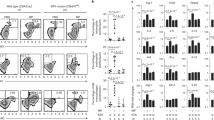Abstract
The involvement of T cells in the progression of inflammation in response to wear debris at the interface of aseptically loosened joints is currently undefined. This cell type has repeatedly been demonstrated to be a common component of the cellular membrane, the interface, which forms between the bone and implant of total joint replacements (TJRs) [1, 2]. Three further insights into the role of this cell type in the interface were investigated here. Immunostaining demonstrated CD4 expression in 80% of the 15 cases tested while CD8 expression was present in 60% of the cases. Polymerase chain reaction (PCR) detected IFN-γ mRNA expression in 75% of eight cases tested; in contrast IL-10 mRNA was only demonstrated in 50% of these same cases. Proteins extracted from another eight cases of revision tissue were analyzed using Western blotting for IL-17, fractalkine (Fkn) and CD40. IL-17 and Fkn were a consistent feature of all cases tested (8/8), while CD40 was undetectable in one case (7/8). These results show that T cells present in the interface are more commonly of the helper T cell phenotype, although cytotoxic T cells are also present. Helper T cells (Th) are responsible for the polarization of the immune response through their production of key mediators. The PCR results obtained in this study suggest that a Th1 response characterized by the production of IFN-γ predominates over the Th2, IL-10 mediated response. Furthermore the demonstration of the expression of IL-17, Fkn and CD40, all of which are Th1 associated molecules, supports this conclusion.
Similar content being viewed by others
References
C. M. Weyand, A. Geisler, A. Brack, M. E. Bolander and J. J. Goronzy, Lab. Invest. 78 (1998) 677.
B. Hercus and P. A. Revell, J. Mater. Sci. 12 (2001) 1063.
T. F. Li, S. Santavirta AND V. Waris, Acta. Orthop. Scand. 72 (2001) 241.
C. M. Weyand, E. Bryl and J. J. Goronzy, Arch. Immunol. Ther. Exp. 48 (2000) 429.
M. L. Kapsenberg, E. A. Wierenga, F. E. Stiekema, A. M. Tiggelman and J. D. Bos, J. Invest. Dermatol. 98 (1992) 59.
L. Budinger and M. Hertl, Allergy. 55 (2000) 108.
R. L. Van Bezooijen, H. C. Farih-Sips, S. E. Papapoulos and C. W. Lowik, J. Bone. Miner. Res. 14 (1999) 1513.
S. Kotake, N. Udagawa and M. Takahashi, J. Clin. Invest. 103 (1999) 1345.
P. Fraticelli, M. Sironi and G. Bianchi, J. Clin. Invest., 107 (2001) 1173.
B. Lienenluke, T. Germann, R. A. Kroczek and M. Hecker, Eur. J. Immunol. 30 (2000) 2864.
S. Saeed and P. A. Revell, Int. J. Exp. Pathol. 82 (2001) 201.
Author information
Authors and Affiliations
Rights and permissions
About this article
Cite this article
Hercus, B., Saeed, S. & Revell, P.A. Expression profile of T cell associated molecules in the interfacial tissue of aseptically loosened prosthetic joints. Journal of Materials Science: Materials in Medicine 13, 1153–1157 (2002). https://doi.org/10.1023/A:1021137921463
Issue Date:
DOI: https://doi.org/10.1023/A:1021137921463




